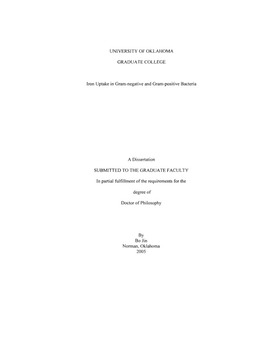| dc.description.abstract | Bacteria, including both Gram-positive and Gram-negative bacteria, utilize iron sources from the environment. Iron uptake systems in Gram-negative bacteria are well studied. Escherichia coli FepA transports certain catecholate ferric siderophores, but not others (Annamalai et al. , 2004), nor noncatecholate compounds (Annamalai et al., 2004). Direct binding and competition experiments demonstrated that this selectivity originates during the adsorption stage. The synthetic tricatecholate Fe-TRENCAM bound to FepA with 50- to 100-fold-lower affinity than Fe-enterobactin (FeEnt), despite an identical metal center and Fe-corynebactin only bound at much higher concentrations. Neither Fe-agrobactin nor ferrichrome bound at all, even at concentrations 106-fold above the Kd. Thus, FepA only adsorbs catecholate iron complexes and it selects FeEnt among even its close homologs. I used alanine scanning mutagenesis to study the contributions of surface aromatic residues to FeEnt recognition. Although not apparent from crystallography, aromatic residues in L3, L5, L7, L8, and L10 affected the interaction between FepA and FeEnt. Among 10 substitutions that eliminated aromatic residues, Kd increased as much as 20-fold (Y481A and Y638A) and Km increased as much as 400-fold (Y478A), showing the importance of aromaticity around the pore entrance. Although many mutations equally reduced binding and transport, others caused greater deficiencies in the latter. Y638A and Y478A increased Km 10- and 200-fold more, respectively, than Kd. The N-domain loop deletions created the same phenotype: Delta60-67 (in NL1) and Delta98-105 (in NL2) increased Kd 10- to 20-fold but raised Km 500- to 700-fold. W101A (in NL2) had little effect on Kd but increased Km 1,000-fold. These data suggested that the primary role of the N terminus is in ligand uptake. Fluorescence and radioisotopic experiments showed biphasic release of FeEnt from FepA. In spectroscopic determinations, koff1 was 0.03/s and koff2 was 0.003/s. However, FepAY272AF329A did not manifest the rapid dissociation phase, corroborating the role of aromatic residues in the initial binding of FeEnt. Thus, the beta-barrel loops contain the principal ligand recognition determinants and the N-domain loops perform a role in ligand transport. | en_US |
